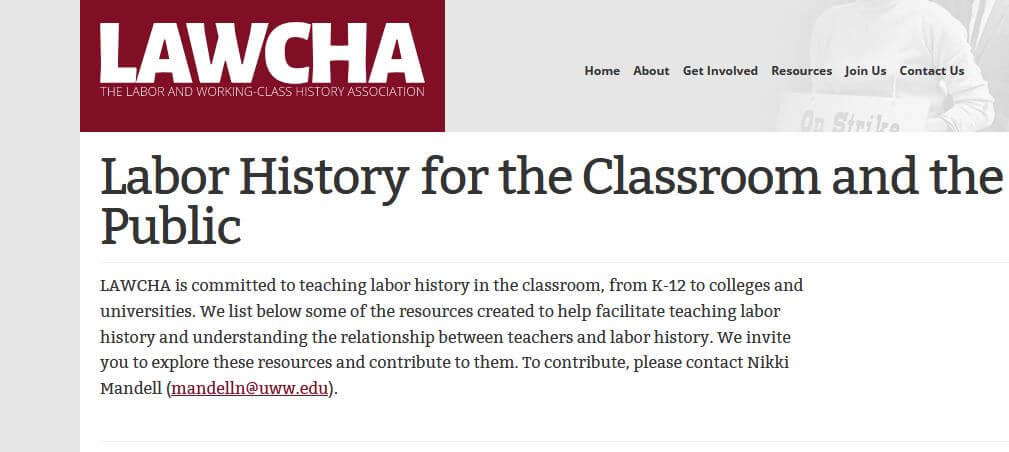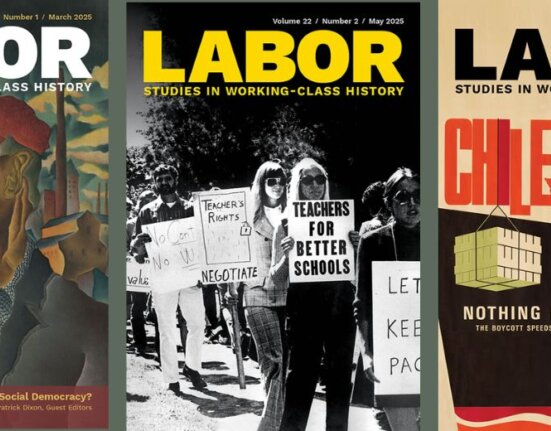Ed: This is one of a series of conference notes from the recent LAWCHA conference. If you have reflections from one of the panels or plenaries, please send them along.
Teaching Labor’s Story: A Mission and a Workshop
The Trump years and rise of white nationalism in the United States and Europe has given new urgency to the work of the Labor and Working-Class History Association and to democracy-loving historians. Whereas previous calls to engage the public with labor and working-class perspectives were few and far between, today’s scholars and their professional historical organizations are better prepared and more willing to engage. Social media has certainly helped ease the transition, and Trump’s agenda has raised the stakes.
Between May 30th and June 1st, 2019 historians, librarians, activists, teachers and members of the public gathered at Duke University for LAWCHA’s “Workers on the Move: Workers’ Movements” conference. This year, in addition to the traditional research-focused panels, conference attendees had the opportunity to attend a number of sessions focused on the more public and outward facing work of our discipline. The increased number of these sessions with an emphasis on engaging the public through writing for the press or in developing ambitious digital labor resource projects is an encouraging sign that scholars are taking outreach work seriously. To paraphrase senior scholar Alice Kessler-Harris, labor historians need to learn from the effective way that right-wing think tanks shaped public discourse from the 1980s and take this current opportunity, when energy is high and the need great, to ensure that labor’s story will be accessible to the public into the future.
One of the exciting efforts LAWCHA supports as a part of its outreach effort is the Teaching Labor’s Story project. On Saturday, June 1st about thirty-five people gathered in a classroom to participate in a workshop session designed to welcome new writers to the project and get started on developing new entries for the project. The energy in the room was high and participants expressed great enthusiasm for the project.
Teaching Labor’s Story is a peer-reviewed, web-published repository of curated primary sources supported by custom-written teaching guides. The project, launched in 2015 by Nikki Mandell and LAWCHA’s Teaching Resources committee, grew from LAWCHA’s larger interest in developing accessible materials about labor history for teachers and wider public. The project considers the fact that many teachers lack training the labor history and find themselves under incredible pressures.. For these reasons, TLS considers the broad curriculum that shapes most U.S. social studies textbooks and is designed to make it possible for any teacher to incorporate stories from labor and working-class history into their courses. Using the National Council for History in the School’s chronological organization, the project divides primary sources among ten historical eras. Using primary sources as the key to unlocking labor’s story and historical thinking skills, TLS authors select sources to reveal historically significant perspectives on essential historical questions. If the original source is longer than 1,000 words, scholars edit them for classroom use. Each source is also annotated to include curricular connections, citation, brief contextualizing essay that explains historical significance, glossary terms, discussion points, document questions, questions relating to the historical period and to labor history more generally. A list of additional sources completes the entry. In four-to-five pages, a TLS annotated source provides teachers a guide to a primary source and a curated opportunity to bring workers’ voices and perspectives into their students’ understanding of the past.
The TLS workshop provided an opportunity to explain the project and begin to develop possible primary source projects. Sources discussed touched on some of the big themes, personalities and events of our field. Some of these included Fania Cohn’s 1936 article “Can Women Lead?”; Hazel Dickens’s 1935 “Black Lung” song, IWW cartoons and newspaper articles from the period between 1905 and 1917; a 1886 Chicago newspaper report on the events of Haymarket, and a 1917 Bisbee, Arizona press article about the Bisbee deportation among others. In the end, we all committed to developing our source into a full-fledged entry and to submitting it for peer-review with September 1 as a working deadline.
Developing an entry for the project is an easy way to contribute to the larger effort of making labor’s story more accessible to a wider public. One graduate student who attended the session was particularly enthusiastic about the possibility of writing a peer-reviewed entry and promised to spread the word to her colleagues. We hope you will too. If you have had labor history training and would like to submit an entry to the project, please contact us at lawcha.tls@gmail.com. We will ensure that your source is appropriate and provide you with a template and detailed instructions. We hope to hear from you soon.







